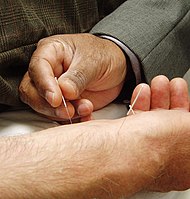
Photo from wikipedia
Introduction Patients with cancer (PC) are at high risk of acquiring COVID-19 and can develop more serious complications. Deeper understanding of vaccines immunogenicity in this population is crucial for adequately… Click to show full abstract
Introduction Patients with cancer (PC) are at high risk of acquiring COVID-19 and can develop more serious complications. Deeper understanding of vaccines immunogenicity in this population is crucial for adequately planning vaccines programs. The ONCOVac study aimed to comprehensively assess the immunogenicity of mRNA-1273 vaccine in terms of humoral and cellular response. Methods We conducted a prospective, single-center study including patients with solid tumours treated with Cyclin-dependent kinases 4 and 6 inhibitors (CDK4/6i), immunotherapy (IT) or chemotherapy (CT). Patients were enrolled previously to vaccination with mRNA-1273. We also involved health care workers (HCW) to serve as a control group. We took blood samples before first dose administration (BL), after first dose (1D), and after second dose (2D). The primary objective was to compare the rate and magnitude of T-cell response after second dose whereas safety and humoral response were defined as secondary objectives. We also collected patient reported outcomes after both the first and second vaccine dose and a 6-month follow-up period to diagnose incident COVID-19 cases was planned. Results The rate of specific anti-S serologic positivity (anti-S IgG cut-off point at 7,14 BAU/ml) was significantly higher in HCW compared to PC after 1D (100% vs 83.8%; p=0.04), but similar after 2D (100% vs 95.8%; p=0.5). This difference after 1D was driven by PC treated with CT (100% vs 64.5%; p=0.001). Cellular response after 2D was significantly lower in PC than in HCW for both CD4+ (91.7% vs 59.7%; p=0.001) and CD8+ (94.4% vs 55.6%; p<0.001) T-cells. We found a difference on pre-existing CD4+ T-cell response in HCW comparing to PC (36% and 17%, p=0.03); without difference in pre-existing CD8+ T-cell response (31% and 23%, p=0.5). After excluding patients with pre-existing T-cell response, PC achieved even lower CD4+ (50.9% versus 95.5%, p<0.001) and CD8+ (45.5% versus 95.5%, p<0.001) T-cell response compared with HCW. Regarding safety, PC reported notably more adverse events than HCW (96.6% vs 69.2%, p<0.001). Conclusion We demonstrated that PC showed a similar humoral response but a lower T-cell response following 2 doses of mRNA-1273 vaccination. Further studies are needed to complement our results and determine the implication of low T-cell response on clinical protection of PC against COVID-19.
Journal Title: European Journal of Cancer
Year Published: 2022
Link to full text (if available)
Share on Social Media: Sign Up to like & get
recommendations!